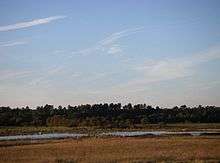Dingle Marshes

Dingle Marshes is a wildlife reserve on the North Sea coast of the English county of Suffolk. The reserve is located between Dunwich and Walberswick, approximately 4 miles (6.4 km) south-west of Southwold. The marshes make up part of the Suffolk Coast National Nature Reserve along with reserves at Walberswick and Hen Reedbeds.[1][2] They are owned jointly by the RSPB and Suffolk Wildlife Trust and are managed by these two organisations and Natural England.[2][3]
The reserve covers 93 hectares (230 acres), is within the Minsmere-Walberswick Heaths and Marshes Site of Special Scientific Interest and is a Natura 2000 site.[3] It is an internationally important site for the starlet sea anemone as well as a key site for bitterns and marsh harriers within the UK.[1] It was purchased in 1999 at a cost of £1 million, aided by a grant from the Heritage Lottery Fund of £559,000.[4]
Landscape
The marshes form part of the open coastal fen landscape type within Suffolk which is predominantly open with few trees.[5] They were drained for use as cattle grazing at some point before 1587 but have reverted to fen land after mid-20th century reflooding.[5]
Habitat

The marshes include a mixture of coastal and freshwater wetland habitats, including brackish pools.[6] These provide breeding habitats for birds such as bitterns, marsh harriers and bearded tits as well as mammals such as otters and water vole and over-wintering locations for species such as avocets, white-fronted geese, lapwings and redshanks.[1][3][6] The site is an internationally important habitat of the starlet sea anemone, the rarest sea anemone in Britain.[1][3] The reserve is bordered by heathland and forest on the landward side and includes a vegetated shingle bank on the seaward side. Little terns often nest along the bank.[6]
Flooding
Coastal flooding has affected the marshes in recent years, including in 2003, 2006 and 2007.[7][8] The shingle bank was breached in 2006 and 2007 leading to concerns that vulnerable freshwater habitats could be lost, including the breeding grounds of species such as bitterns.[7][8][9] Emergency flood defence works were carried out by the Environment Agency following the 2006 breech,[9] and these were extended in 2012 to provide additional flood defences for the reserve.[10]
Facilities
The reserve is accessed from the south at Dunwich beach where a car park and other facilities are maintained by Suffolk Coastal District Council. A circular walk is waymarked around the marshes. The RSPB maintains a hide overlooking the marsh.[6]
References
- 1 2 3 4 Suffolk Coast NNR, Natural England. Retrieved 2012-10-30.
- 1 2 Suffolk Coast National Nature Reserve, Direct enquiries. Retrieved 2012-10-30.
- 1 2 3 4 Dingle Marshes, Suffolk Wildlife Trust. Retrieved 2012-10-30.
- ↑ Lottery helps rare species, BBC news website, 1999-02-10. Retrieved 2012-10-31.
- 1 2 Open coastal fens, Suffolk county council. Retrieved 2012-10-30.
- 1 2 3 4 About Dingle Marshes, RSPB. Retrieved 2012-10-30.
- 1 2 Sea breaches RSPB reserves in Suffolk, Bird Guide, 2006-11-02. Retrieved 2012-10-30.
- 1 2 Surge hits wildlife havens, BBC news website, 2007-11-09. Retrieved 2012-10-31.
- 1 2 Fears for Dingle marshes, Eastern Daily Press, 2007-01-03. Retrieved 2012-10-30.
- ↑ Flood protection work at Minsmere and Dingle Marshes, BBC news website, 2012-10-15. Retrieved 2012-10-30.
Coordinates: 52°17′07″N 1°37′45″E / 52.2854°N 1.62929°E